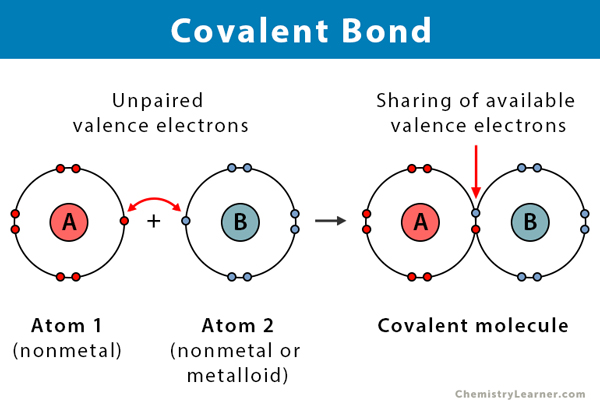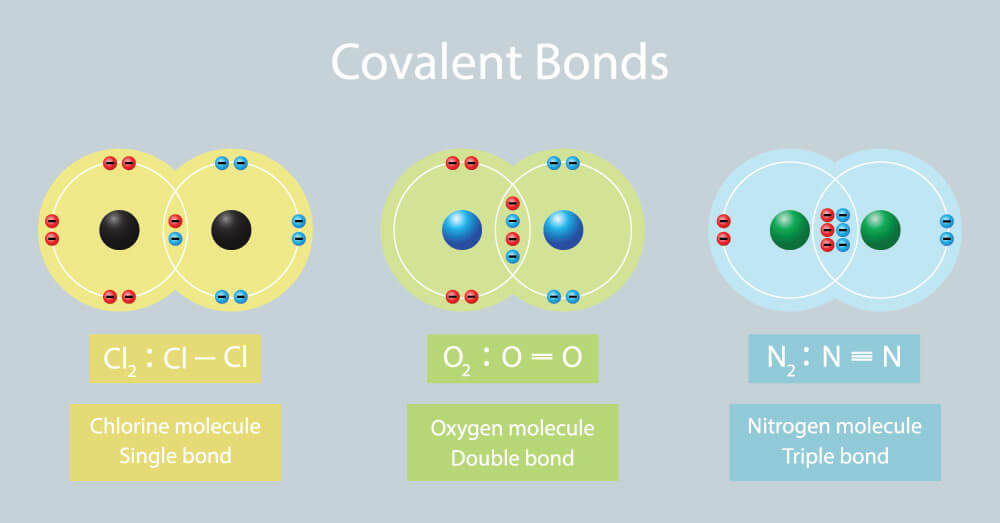N-F A I only B II only C III only D I and III E I II and III 3 Which of the following BEST describes the bonding found within solid Al 2 O 3. O NH Br O COO O NH4OH MgCl2 O CH2Cl2 When a liquid freezes O AS is negative and heat is absorbed.

Covalent Bond Definition Properties Examples Facts Britannica
Electrons are completely transferred between two metals.

. 2 Which of the following bonds would be best categorized as covalent. Bond order describes the number of covalent bonds shared by two atoms. Two atoms sharing a pair of electrons.
However when you place covalent compounds in water they typically do not dissolve but form a layer on top of the water. Each of these chlorine atoms only requires one more valence electron to finish its outer shell. The diagrams below show the.
A covalent bond is a shared pair of electrons between two non-metal atoms for example carbon dioxide. The Different Kinds of Compounds Chemical compounds are generally grouped into one of two categories. An atom consists of a positively charged nucleus and negatively charged electrons that surround it.
Covalent compounds that contain carbon and hydrogen are called organic compounds. Consider two chlorine atoms each of which has seven valence electrons. O AS is negative and entropy decreases.
Here we discuss two classes of compounds based on the bond type that holds the atoms together. Covalent bonds are characterized by the sharing of electrons between two or more atoms. AS is positive and heat is absorbed.
Covalent or molecular compounds contain atoms held together by covalent bonds. A way in which elements combine to form compounds while attaining a noble-gas electronic configuration. O AS is positive and entropy decreases.
A shared pair of electrons represents a covalent bonds. In such a case covalence prevails. A covalent compound is a molecule formed by covalent bonds in which the atoms share one or more pairs of valence electrons.
You can recognize these compounds because they consist of nonmetals bonded to each other. These are examples of covalent bonds and covalent compounds. Covalent Compounds in Water A chemical compound is made up of many identical molecules formed from atoms from more than one element attached by chemical bonds.
A discrete group of atoms connected by covalent bonds is called a molecule. The smallest possible unit of a covalent compound is a an molecule. The smallest part of a compound that retains the chemical identity of that compound.
Covalent bonds can be best described as. The electronegativity difference between two atoms is very large. They have distinct chemical structures characterized by a fixed ratio of atoms held together by chemical bonds.
A discrete group of atoms connected by covalent bonds. Covalent hydrides are primarily compounds of hydrogen and nonmetals in which the bonds are evidently electron pairs shared by atoms of comparable electronegativities. Covalent compounds that predominantly contain carbon and hydrogen are called organic compounds.
The convention for representing the formulas of organic compounds is to write carbon first followed by hydrogen and then any other elements in alphabetical order eg CH 4. As a general rule covalent bonds are formed between elements lying toward the right in the periodic table ie the nonmetals. Pairs of electrons are shared between two nonmetal atoms.
The convention for representing the formulas of organic compounds is to write carbon first followed by hydrogen and then any other elements in alphabetical order eg CH 4 O is methyl alcohol a fuel. Two nonmetal atoms are attracted to each other by opposite charges. For example a CLC bond has a bond order of 1 a CAC bond has a bond order of 2 and a CC bond has a bond order of 3.
These giant molecular structures are basically lattices made up of molecules which are held together by covalent bonds structure. Which of the following statements correctly describe covalent compounds. They are best described as neutral atoms held together by covalent bonds and are essentially one giant molecule.
These covalent bonds are very strong. These bonds form when the atoms share electrons because they have similar electronegativity values. The atoms form a single bond by sharing two electrons.
13 STRUCTURES OF COVALENT COMPOUNDS 15 2. Neutral atoms coming together to share electrons. A Strong covalent bonds between atoms with similar electronegativities.
The example of this kind of covalent compounds includes diamond and graphite of carbon atom. O AS is negative and disorder increases. If two pairs of electrons are shared between two atoms a double bond exists and when two atoms share three pairs of electrons a triple bond exists.
They also tend to be very hard with high melting points which are different from most of the covalent compounds. Chemists frequently use Lewis diagrams to represent covalent bonding in molecular substances. When none of the elements in a compound is a metal no atoms in the compound have an ionization energy low enough for electron loss to be likely.
It is best described. A triple bond involves the sharing of ________ pairs of electrons between the atoms. A chemical bond formed when two atoms share six electrons is a ________ bond.
Organic compounds such as carbohydrates lipids proteins and nucleic acids are all examples of molecular compounds. However not all compounds are created equally. In chemical compounds covalent bonds form when.
Covalent compounds also are known as molecular compounds. - Covalent compounds are formed by sharing electrons between atoms - Most of the compounds that we come in contact with are covalent compounds - Covalent compounds contain covalent bonds - Nitrogen N2 is a covalent compound - Covalent compounds are formed by transferring. Chemistry questions and answers.
Bond lengths decrease with increasing bond order. Which is best described as a covalent compound. These bonds form when the atoms share electrons because they have similar electronegativity values.
Phosphorous P and chlorine Cl bond covalently to form the important industrial compound phosphorous trichloride.

Ch150 Chapter 4 Covalent Bonds And Molecular Compounds Chemistry

Covalent Bond Definition Types And Examples


0 Comments